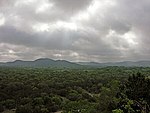| Texas Hill Country | |
| Region | |
|
Hill Country, Bandera County
|
|
| Country | |
|---|---|
| State | |
| Region | Central Texas |
| Coordinates | |
| Highest point | |
| – elevation | 750 m (2,461 ft) |
| Lowest point | |
| – elevation | 300 m (984 ft) |
| Website: Handbook of Texas: Hill Country | |
The Texas Hill Country is a vernacular term applied to a region of Central Texas, that features tall rugged hills that consist of thin layers of soil lying on top of either limestone or granite.[1] It also includes the Llano Uplift and the second largest granite monadnock in the United States, Enchanted Rock, which is located 18 miles (29 km) north of Fredericksburg. The Hill Country reaches into portions of the two major metropolitan areas of Central Texas, especially in San Antonio‘s northern suburbs and the western half of Travis County, ending just west of downtown Austin. The region is the eastern portion of the Edwards Plateau and the easternmost region of the American Southwest, and is bound by the Balcones Fault on the east and the Llano Uplift to the west and north. The terrain is punctuated by a large number of limestone or granite rocks and boulders and a thin layer of topsoil, which makes the region very dry and prone to flash flooding. The Texas Hill Country is also home to several native Southwestern types of vegetation, such as various yucca, Prickly Pear Cactus, and the dry Southwestern tree known as the Texas Live Oak.[2]
Several cities were settled at the base of the Balcones Escarpment, including Austin, San Marcos, and New Braunfels, as a result of springs discharging water stored in the Edwards Aquifer.
Counties in the Texas Hill Country
According to the Texas Parks and Wildlife Department, the following 25 counties comprise the Texas Hill Country:[3]
Natural features
Because of its karst topography, the area also features a number of caves, such as Inner Space Caverns, Natural Bridge Caverns, Bracken Cave, and Wonder Cave. The deeper caverns of the area form several aquifers which serve as a source of drinking water for the residents of the area.
Several tributaries of the Colorado River of Texas — including the Llano and Pedernales rivers, which cross the region west to east and join the Colorado as it cuts across the region to the southeast – drain a large portion of the Hill Country. The Guadalupe, San Antonio, Frio, Medina, and Nueces rivers originate in the Hill Country.
This region is a dividing line for certain species occurrence. For example, the California Fan Palm (Washingtonia filifera) is the only species of palm tree that is native to the continental United States west of the Hill Country’s Balcones Fault.[4]
The region has hot summers, particularly in July and August, and even the nighttime temperatures remain high, as the elevation is modest despite the hilly terrain. Winter temperatures are sometimes[specify] as much as ten degrees cooler than in other parts of Texas to the east.[citation needed]
|
View of the Texas Hill Country, from Garner State Park, located in Uvalde County. |
House atop hill in Texas Hill Country north of Bandera |
Popular culture
The area is also unique for its fusion of Spanish and Central European (German, Swiss, Austrian, Alsatian, and Czech) influences in food, beer, architecture, and music that form a distinctively “Texan” culture separate from the state’s Southern and Southwestern influences.[1] For example, the accordion was popularized in Tejano music in the 19th century due to cultural exposure to German settlers.
Devil’s Backbone appeared in a 1996 episode of Unsolved Mysteries featuring ghosts of a Spanish Monk, a Native American, Confederate Soldiers on their horses, and a wolf spirit.
In recent years, the region has emerged as the center of the Texas wine industry.[citation needed] Three American Viticultural Areas are located in the areas: Texas Hill Country AVA, Fredericksburg in the Texas Hill Country AVA, and Bell Mountain AVA.
The Hill Country is also known for its tourism. In 2008, The New York Times declared it “the No. 1 vacation spot in the nation.” The Hill Country has also made Texas second to Florida as the most popular retirement destination in the United States. The region has attracted Baby Boomers as they near retirement age.[5]
Frederick Day, a demographer with Texas State University in San Marcos, said that the Hill Country life-style reminds one of the small towns of the recent past. “Like old America . . . [the] cost of living is pretty low. To people who have spent their work life in Houston or Dallas, the Hill Country is very attractive.”[5]
For more information About the Texas Hill Country, contact:






